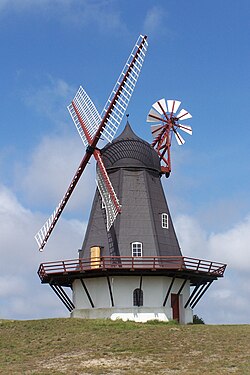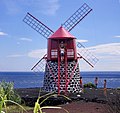Portal:Wind power
The Wind Power Portal

Wind power is the use of wind energy to generate useful work. Historically, wind power was used by sails, windmills and windpumps, but today it is mostly used to generate electricity. This article deals only with wind power for electricity generation. Today, wind power is generated almost completely with wind turbines, generally grouped into wind farms and connected to the electrical grid.
In 2022, wind supplied over 2000 TWh of electricity, which was over 7% of world electricity and about 2% of world energy. With about 100 GW added during 2021, mostly in China and the United States, global installed wind power capacity exceeded 800 GW. To help meet the Paris Agreement goals to limit climate change, analysts say it should expand much faster - by over 1% of electricity generation per year. (Full article...)
Selected article -

Wind is the natural movement of air or other gases relative to a planet's surface. Winds occur on a range of scales, from thunderstorm flows lasting tens of minutes, to local breezes generated by heating of land surfaces and lasting a few hours, to global winds resulting from the difference in absorption of solar energy between the climate zones on Earth. The two main causes of large-scale atmospheric circulation are the differential heating between the equator and the poles, and the rotation of the planet (Coriolis effect). Within the tropics and subtropics, thermal low circulations over terrain and high plateaus can drive monsoon circulations. In coastal areas the sea breeze/land breeze cycle can define local winds; in areas that have variable terrain, mountain and valley breezes can prevail.
Winds are commonly classified by their spatial scale, their speed and direction, the forces that cause them, the regions in which they occur, and their effect. Winds have various aspects: velocity (wind speed); the density of the gas involved; energy content, or wind energy. In meteorology, winds are often referred to according to their strength, and the direction from which the wind is blowing. The convention for directions refer to where the wind comes from; therefore, a 'western' or 'westerly' wind blows from the west to the east, a 'northern' wind blows south, and so on. This is sometimes counter-intuitive.
Short bursts of high speed wind are termed gusts. Strong winds of intermediate duration (around one minute) are termed squalls. Long-duration winds have various names associated with their average strength, such as breeze, gale, storm, and hurricane. (Full article...)General windmill articles
Topics

A windmill is a structure that converts wind power into rotational energy using vanes called sails or blades, by tradition specifically to mill grain (gristmills), but in some parts of the English-speaking world the term has also been extended to encompass windpumps, wind turbines, and other applications. The term wind engine is also sometimes used to describe such devices. (Full article...)
Examples of multi-sailed windmills
Examples of tower mills
- Aarsdale Windmill
- Blennerville Windmill
- Bourne Windmill, Oakdale, New York
- Elphin Windmill
- Greenhill Windmill
- Gudhjem Windmill
- Montefiore Windmill
- Morgan Lewis Windmill
- Mostert's Mill
- Moulin de Craca
- Myreagre Mølle
- Old Mill, Perth
- Pedersker Kirkemølle
- Scherpenberg mill
- Ta' Kola Windmill
- The Old Windmill, Brisbane
- Vinegar Hill Windmill
- Xarolla Windmill
General images
Subcategories
List articles

- List of onshore wind farms
- Lists of wind farms by country
- List of wind farms in Australia
- List of wind farms in Canada
- List of wind farms in China
- List of wind farms in Denmark
- List of wind farms in India
- List of wind farms in Iran
- List of wind farms in the Republic of Ireland
- List of wind farms in Japan
- List of wind farms in Jordan
- List of wind farms in Kosovo
- List of wind farms in Latvia
- List of wind farms in Lithuania
- List of wind farms in Morocco
- List of wind farms in the Philippines
- List of wind farms in Romania
- List of wind farms in South Africa
- List of wind farms in Sri Lanka
- List of wind farms in Sweden
- List of wind farms in Turkey
- List of wind farms in the United Kingdom
- List of wind farms in the United States
- List of wind farms in Uruguay
- List of offshore wind farms
- List of offshore wind farms in China
- List of offshore wind farms in Denmark
- List of offshore wind farms in Germany
- List of offshore wind farms in Japan
- List of offshore wind farms in the Netherlands
- List of offshore wind farms in Sweden
- List of offshore wind farms in the United Kingdom
- List of offshore wind farms in the United States
Did you know...
- ... that wind power in Turkey is so profitable that companies pay the government for licences?
Need help?
Do you have a question about Wind power to which that you cannot find the answer?
Consider asking it at the Wikipedia reference desk.
Related portals
WikiProjects
Associated Wikimedia
The following Wikimedia Foundation sister projects provide more on this subject:
-
Commons
Free media repository -
Wikibooks
Free textbooks and manuals -
Wikidata
Free knowledge base -
Wikinews
Free-content news -
Wikiquote
Collection of quotations -
Wikisource
Free-content library -
Wikiversity
Free learning tools -
Wiktionary
Dictionary and thesaurus












































































































